What is traffic prediction and how does it work?
&w=256&q=90)

Traffic prediction is the task of forecasting real-time traffic information based on floating car data and historical traffic data, such as traffic flow, average traffic speed and traffic incidents.
Have you ever sat in traffic wondering how much time you could have saved if you weren’t stuck in gridlock? What about if you had taken the left turn at the junction instead of continuing on the highway only for a never-ending queue of vehicles to greet you?
Traffic congestion costs people valuable time, fuel, and frustration every single day. At the same time, large amounts of congestion impact governments who need to keep traffic flowing for the movement of goods, reducing pollution in certain areas, and for the safety of those on the road. Congestion is a global problem that impacts all levels of society. The most common causes of traffic congestion are known by any driver who has come across a traffic jam on their journey. Road incidents such as accidents and roadworks often cause unexpected delays. Bad weather conditions also result in lower-traffic flow speeds, while poor traffic signal timing limits capacity on smaller inner roads. However, the largest increase in global traffic congestion is due to one main cause: there are too many vehicles for a road network with a limited capacity.
You can’t always avoid traffic but with accurate traffic predictions you can make smarter choices that can save you money, time and increase overall road safety. Highly accurate traffic information also helps governments by supporting the development of smart and sustainable mobility systems to reduce overall congestion levels.
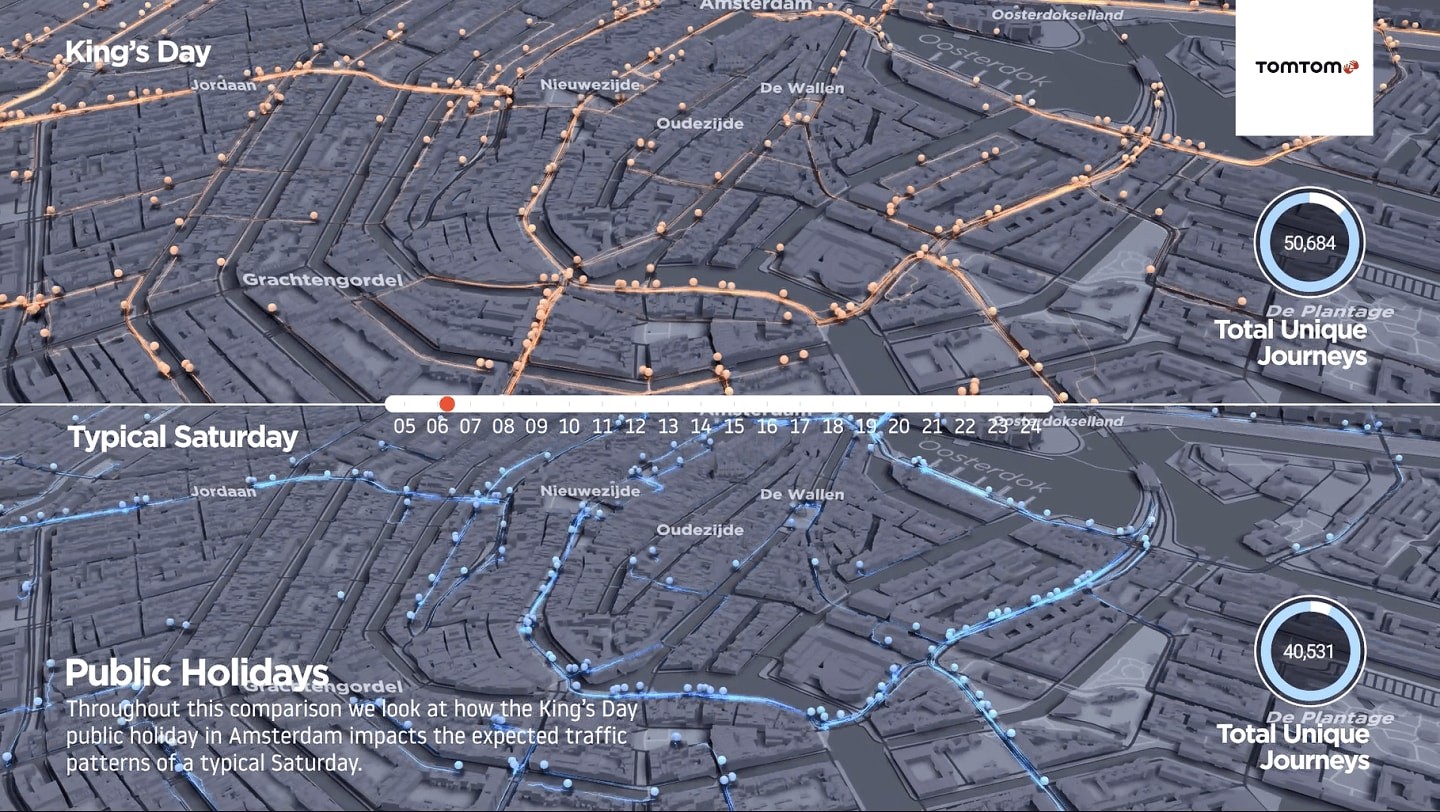
A visual pattern of congestion comparing a normal weekend day to a public holiday.
How can traffic predictions help drivers avoid traffic?
More and more drivers are relying on navigation applications and devices to guide them through the fastest routes and avoid hitting congestion. The best navigation devices use advanced traffic prediction services for accurate estimated times of arrivals (ETAs) and optimized routes during a driver’s journey.
So how does TomTom calculate accurate traffic predictions?
TomTom Traffic delivers two kinds of information in real time: traffic flow speeds and traffic congestion/incidents.
Updated every 30 seconds, our service generates a true picture of traffic for unmatched road network coverage. This information helps users plan trips and daily commutes for a faster and more relaxed journey.
TomTom calculates traffic flow speeds and congestion in real-time, and users can also use this information to predict what the traffic will be up to 24 hours ahead of time. If a driver has an important meeting planned for the next morning, TomTom Traffic gives the user the option to plan ahead to avoid peak hours and arrive on time.
However, much like weather forecasts, the longer the time horizon, the bigger the challenge to achieve highly accurate predictions ahead of time (except during nighttime periods where free-flow speeds are most common). On top of this, unpredictable events such as bad weather conditions or unplanned large protests pose challenges to traffic prediction.
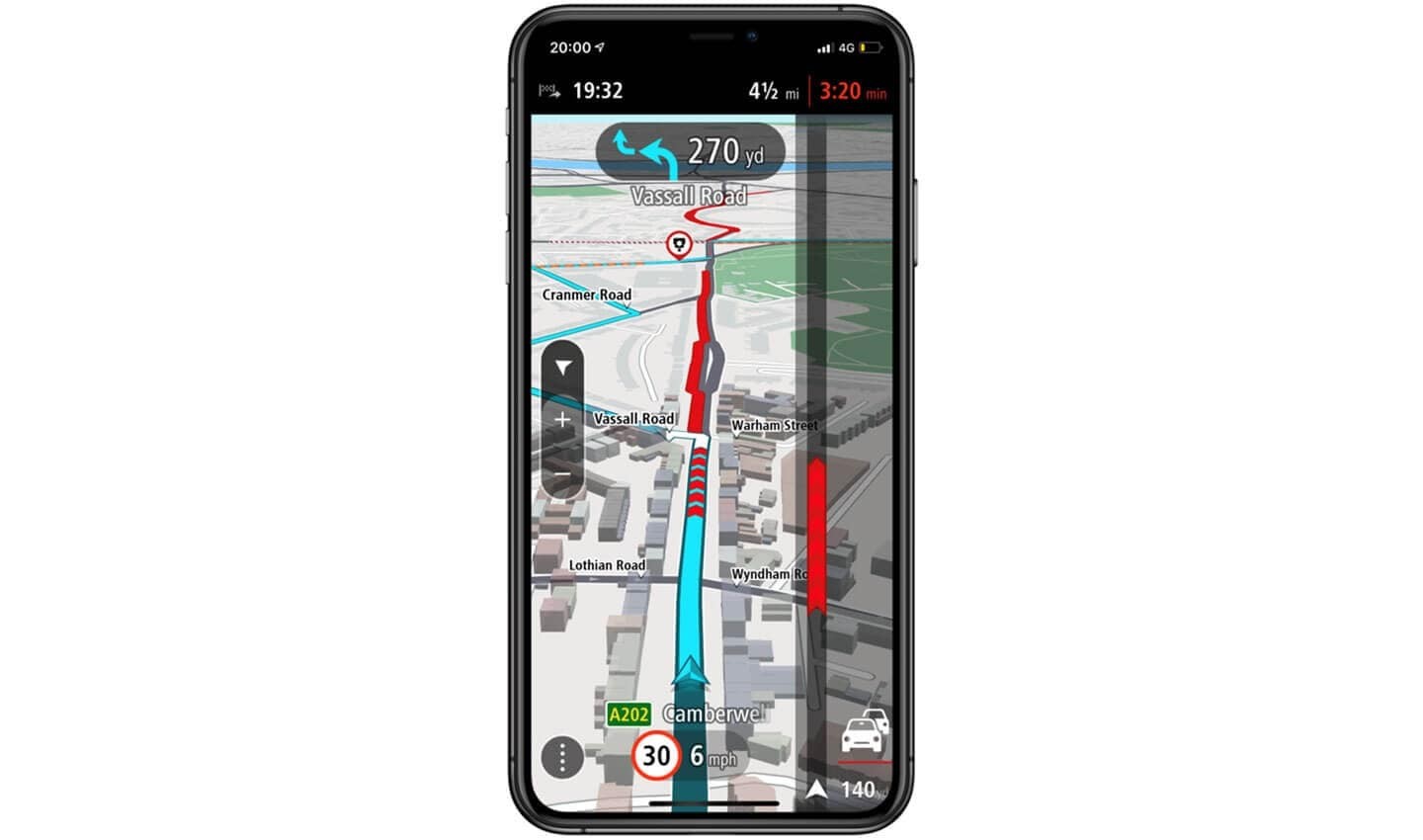
A representation of real-time traffic in the TomTom Go Mobile navigation app.
What is the traffic data collection process?
For the best traffic predictions, data is key. And the more data, the better. To ensure drivers have the most up-to-date and accurate traffic information, we process billions of anonymized data points every 30 seconds. TomTom's historical traffic database has 2,800,000,000,000 (2.8 trillion!) kilometers of trip data, shared by our community of drivers since 2008. That’s the equivalent of 580 billion driving hours.
The benefit of having such an impressive amount of data is that TomTom can tell you the patterns of driving behavior for any day, of any month for almost 15 years. These deep insights are the key ingredient for smarter routing and traffic prediction.
To achieve the unrivaled quality and road coverage of TomTom Traffic, we use a range of sources around the world to generate real-time traffic information. We leverage a global community of over 600 million GPS and floating car data (FCD) probes to measure flow speeds, detect congestion and other incidents on the road in real-time.
We collect this data from multiple sources:
Smartphone partners
Popular ride-hailing and navigation applications
Automotive partners
Fleet management systems
GPS probes from TomTom connected navigation devices and smartphone apps
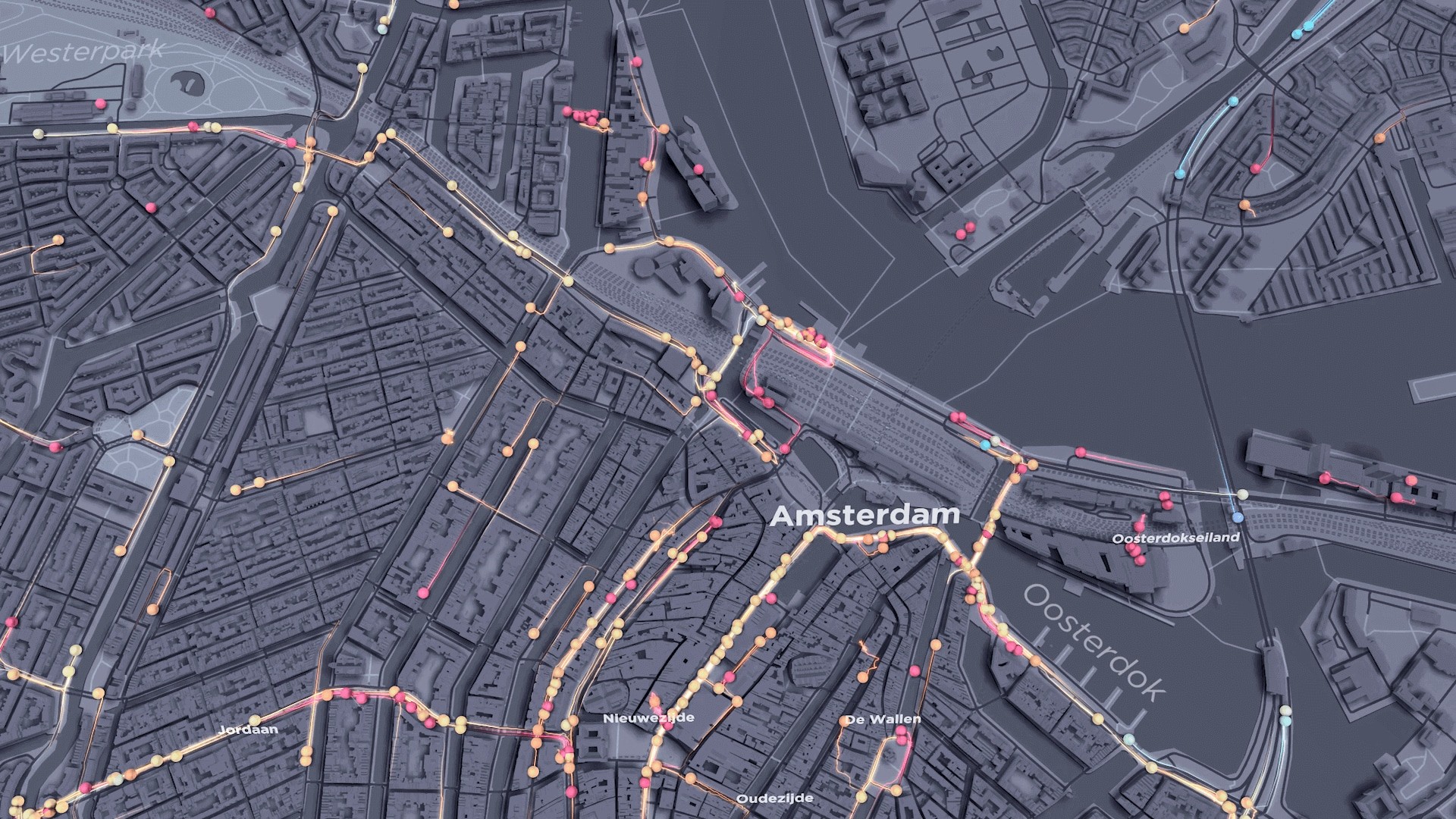
Many local and national authorities have developed data feeds announcing road closures, roadworks, accidents and other relevant information. When road networks quickly communicate this information to road users, drivers can make fast informed decisions to take alternative routes which reduces congestion levels.
TomTom uses this road data wherever possible and provides an option for authorities and trusted partners to directly input this information into TomTom Traffic Information services.
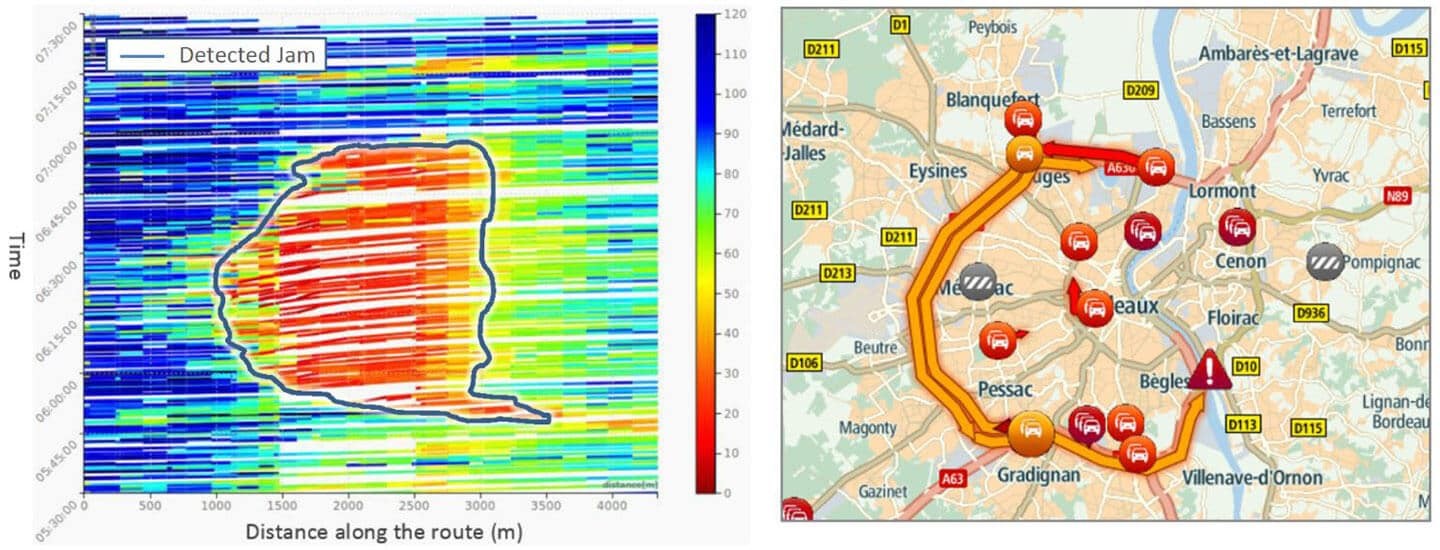
A representation of a time-distance plot chart with color grading reflecting vehicle speeds (red means low speeds). The chart evidences the need for high-resolution probe data to accurately identify heads and tails of jams accurately and timely.
How does traffic prediction make use of machine learning?
TomTom’s fusion engine intelligently combines the data from all available sources every 30 seconds into a database with traffic flow and incident data for the entire road network.
By collecting FCD, TomTom creates and maintains an anonymous archive with actual driven trips for analysis purposes. The ability to map-match and analyze large volumes of data allows TomTom to make traffic predictions at scale. No matter how small or large the road network, the data can produce accurate traffic predictions throughout the day.
TomTom’s traffic fusion engine calculates congestion and delays based on defined free flow traffic thresholds and speed profiles with 3.5 billion kilometers of live trip data collected globally every day. The equivalent of 70 billion driving hours, this provides an extremely detailed predictive traffic baseline for every road, for every day of the week, for every 5-minute interval.
TomTom sources incident data such as road closures and roadworks from trusted 3rd party sources including governmental entities and community input from millions of connected TomTom devices. Internal moderation teams also operate around the world to validate and moderate critical local road reports. On top of this data, TomTom Traffic makes use of weather information and holiday and local event information.
Together, this creates the most accurate and up-to-date picture of the road for the most accurate and advanced traffic prediction available.
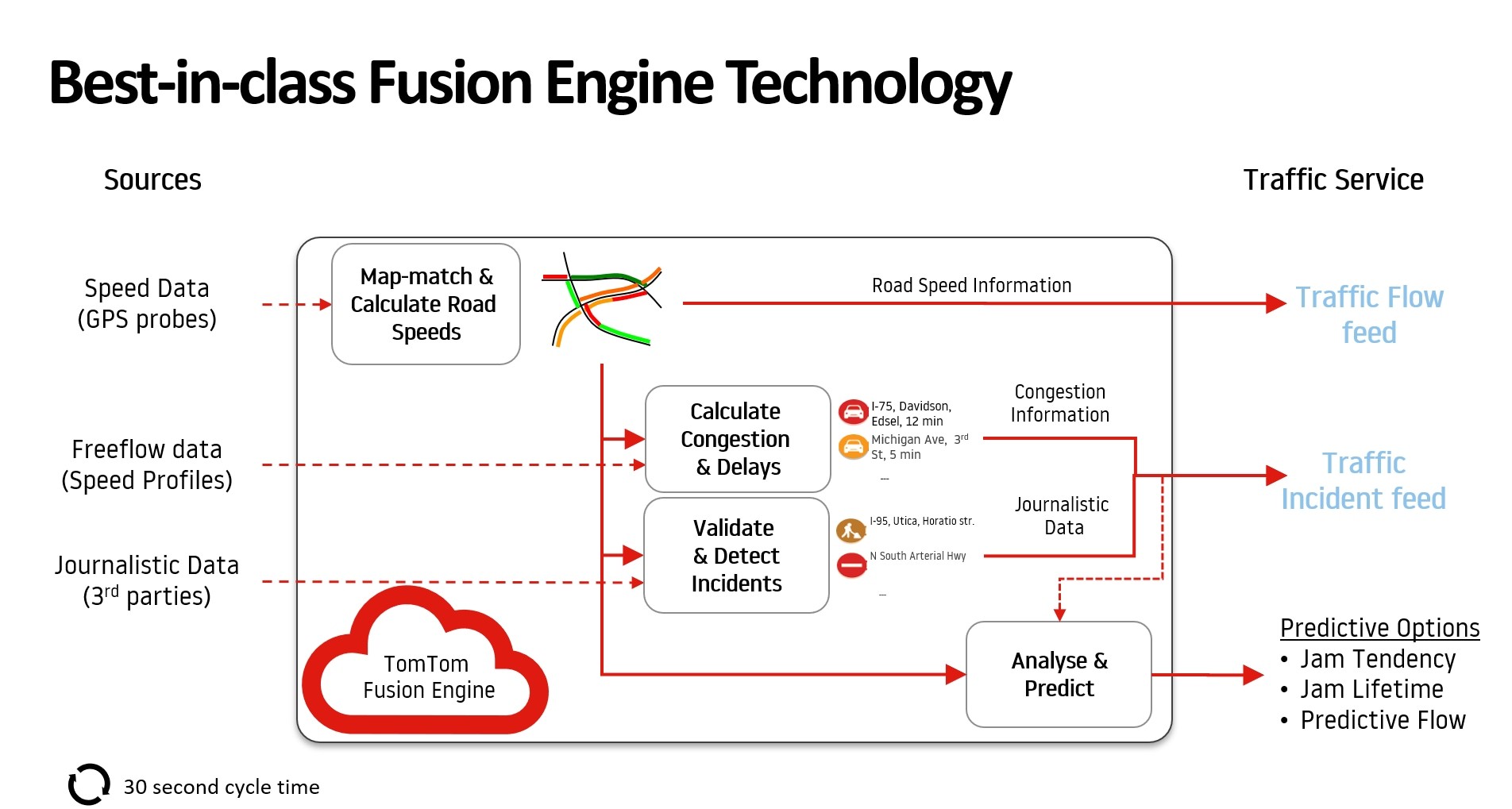 The diagram depicts a high-level view of TomTom Traffic engine process including data ingestion, fusion and delivery.
The diagram depicts a high-level view of TomTom Traffic engine process including data ingestion, fusion and delivery.TomTom exploits different techniques to obtain high quality predictions of traffic, ranging from simple heuristics to statistical methods, traffic simulations and machine learning models. To this end, our traffic engineering teams collaborate with traffic statistics and data science teams who have strong geospatial research backgrounds. Besides predicting drivable speeds for the future, we also predict the occurrence of future jams and how existing jams will evolve over time.
The video below illustrates our jam evolution prediction, which makes use of machine learning models using criteria such as flows into and out of the jam, detected jam front velocities and many others. The combination of top experts in the industry, an abundant amount of traffic data and advanced machine learning technologies allows us to produce the most reliable traffic predictions.
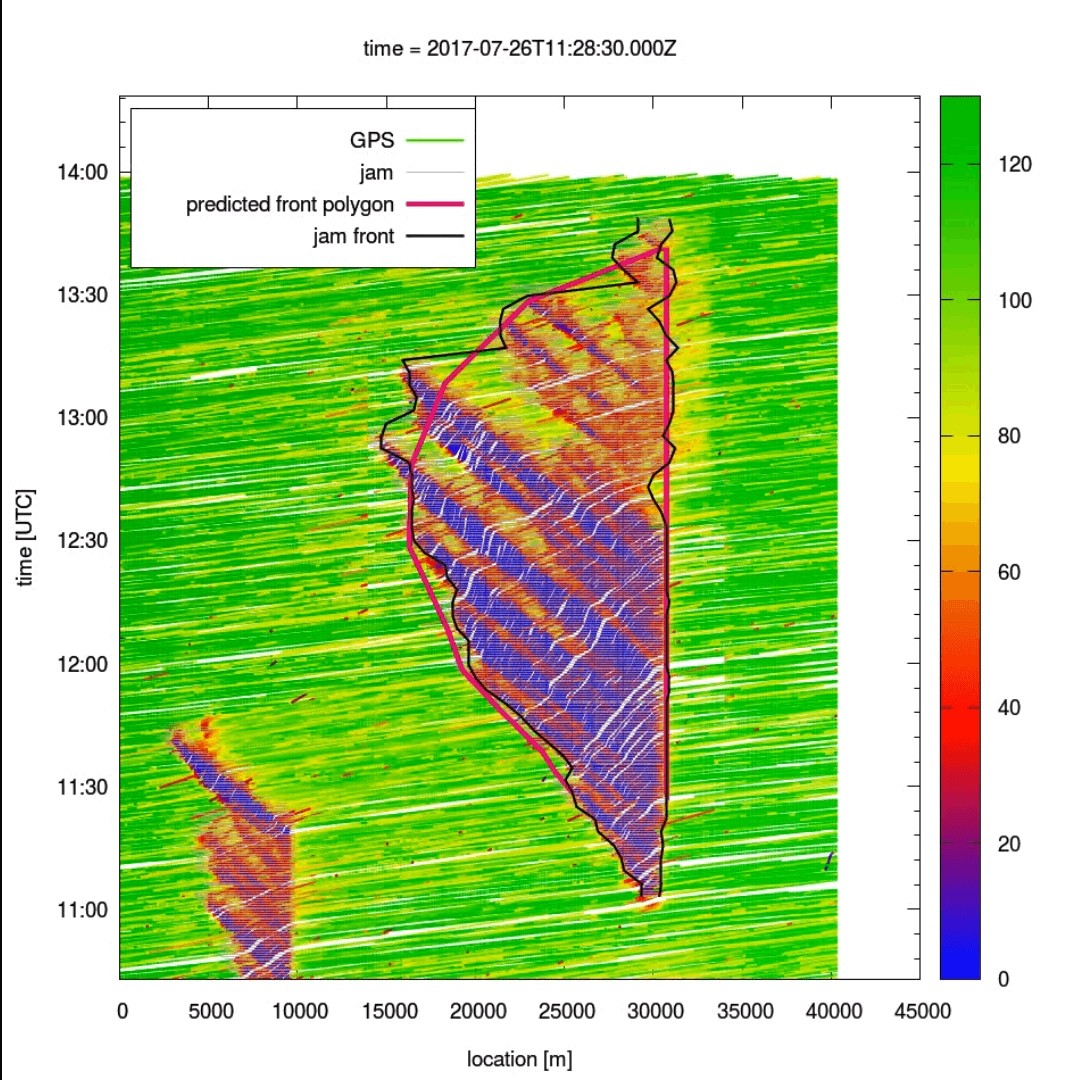
The video shows the performance of a TomTom Traffic prediction visualized in a time-distance plot [F. Wendler et al. A method, apparatus and computer program for generating traffic jam data for a digital map. UK Patent 1918934.9., filed December 20, 2019].
TomTom Real-Time Traffic
TomTom Traffic provides accurate information about traffic jams and expected delays on a planned route, helping drivers make better decisions that save time, reduce stress and make roads safer. It is an accurate, real-time service, driven by more than 600 million connected devices, that collects data on over 3.5 billion km of roadways per day.
TomTom Traffic provides access to two real-time practical travel products:
TomTom Traffic Flow: Delivers a real-time, detailed view of traffic speeds on the entire road network, designed for easy integration into traffic management systems or routing engines to calculate current travel times
TomTom Traffic Incidents: Provides precise locations and delays caused by congestion on the road network, allowing routing programs to provide the fastest route based on actual current travel times
Each feed is composed by its own traffic prediction features:
Jam tendency: Indicates whether a jam is improving, remaining stable, or becoming worse
Jam lifetime: Provides expected duration of a jam
Jam evolution: Provides the predicted spatial and temporal position of the jam, supplemented by the predicted speed throughout the congestion
Future jams: Provides the predicted traffic congestions expected to happen in the future
24-hour flow prediction: Provides for each road stretch the expected flow speed for the upcoming 24 hours
All our traffic feeds are available to all our customers, regardless of their industry: traffic management, automotive and enterprise customers can all make use of TomTom Traffic in their solutions.
TomTom Traffic also uses the industry standards DATEX II and TPEG2 in combination with map-agnostic location methods. In other words, we do all the work to ensure there is minimal effort required to integrate our traffic products into customer solutions.
Learn how TomTom’s Real-Time Traffic can help
Could accurate and up-to-date traffic predictions help solve your traffic management problem?
People also read
)
How traffic impacts navigation: 4 insights on real-time and predictive flow
)
How TomTom and its partners help road authorities solve traffic challenges
)
How to gain back time: The mystery of travel time accuracy debunked
* Required field. By submitting your contact details to TomTom, you agree that we can contact you about marketing offers, newsletters, or to invite you to webinars and events. We could further personalize the content that you receive via cookies. You can unsubscribe at any time by the link included in our emails. Review our privacy policy.